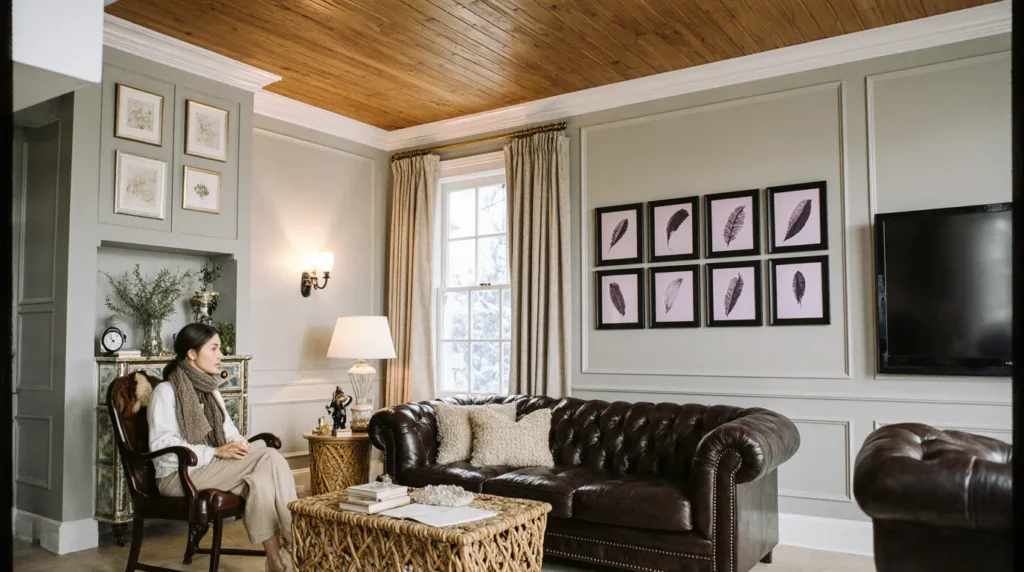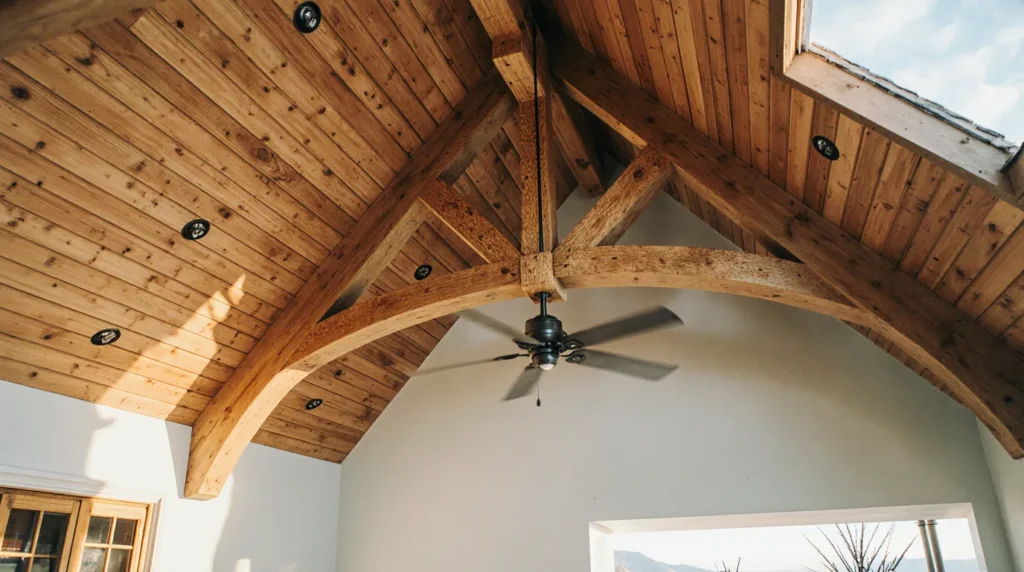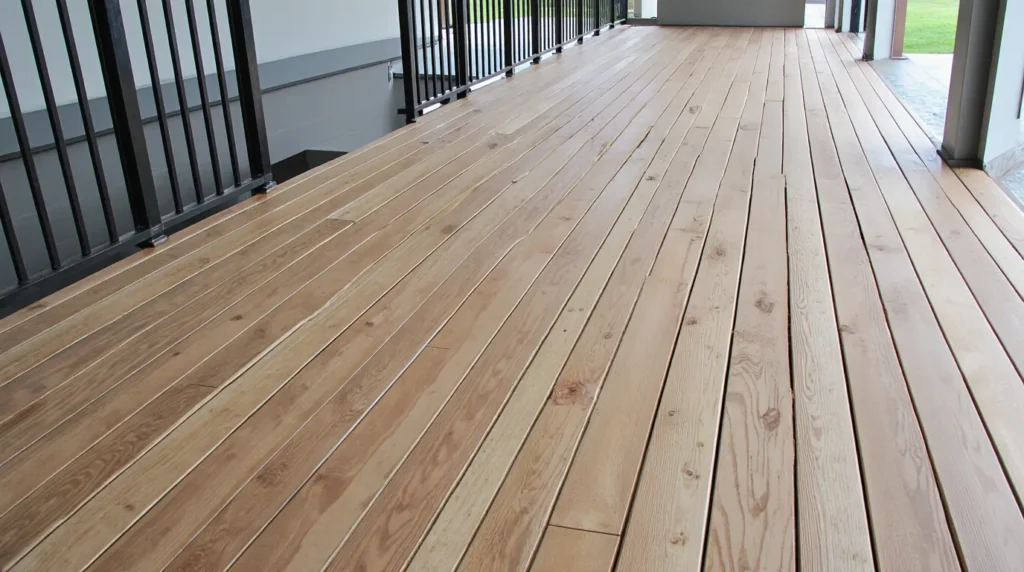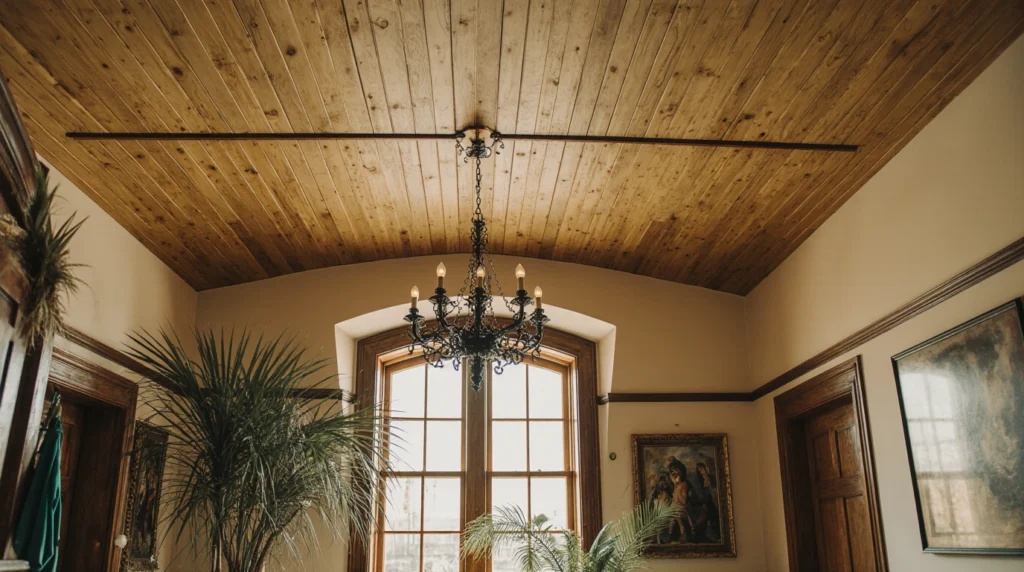
Stunning Tongue and Groove Ceiling Ideas | Design & Installation Tips
Looking for a tongue and groove ceiling that transforms your space without breaking the bank? We’ve been there! After installing this stunning feature in our own home with a ceiling just under 24 feet long, we’re convinced it’s one of the most impactful upgrades you can make.
Tongue and groove ceilings are surprisingly affordable, typically costing between $2.00-$3.50 per square foot depending on your material choices. Whether you’re dreaming of a pine tongue and groove ceiling for your living room or a durable tongue and groove porch ceiling for your outdoor space, the installation process remains relatively straightforward. In fact, for a 300 square foot porch, materials would cost approximately $780. The beauty of these ceilings lies in their versatility – they work equally well for indoor spaces with recessed lighting and speakers or as a tongue and groove outdoor ceiling where you don’t need to worry about matching wood tones perfectly.
If you’re considering this project, you’re in the right place. We’ll walk you through everything from planning to final touches, helping you avoid the 70+ repetitive steps we had to figure out through trial and error. Ready to transform your ceiling from boring to beautiful? Let’s get started!
Table of Contents
Planning Your Tongue and Groove Ceiling Project

Planning a tongue and groove ceiling installation might seem overwhelming at first, yet taking time for thorough preparation makes all the difference between a stunning finished project and frustrating do-overs. Before grabbing your nail gun and climbing that ladder, let’s explore the crucial planning steps that ensure your ceiling installation goes smoothly.
Why planning your tongue and groove ceiling matters
Proper planning prevents the most common tongue and groove ceiling installation pitfalls. First and foremost, planning allows you to:
- Determine the exact materials needed
- Calculate accurate costs
- Decide on finishing options before installation
- Avoid mid-project surprises
One of the most valuable aspects of planning is material acclimation. Storing your tongue and groove boards in the installation room for a couple of weeks reduces future swelling or shrinking. This acclimation period is particularly important because wood naturally expands and contracts with seasonal changes. For optimal results, I recommend priming or staining both sides of your boards before installation to prevent cupping.
Additionally, planning helps determine if you’ll need furring strips (battens), which provide a solid mounting surface while helping level out any bumps or uneven areas in your existing ceiling. These strips also give you flexibility to change the direction of your tongue and groove boards from perpendicular to parallel with the joists.
Choosing between indoor and tongue and groove outdoor ceiling
The versatility of tongue and groove ceilings extends beyond just indoor spaces. These beautiful ceilings work excellently for outdoor areas like covered patios, charming porches, and outdoor kitchens. When choosing between indoor and outdoor applications, consider these key differences:
For outdoor tongue and groove ceilings, focus on:
- Weather resistance – You’ll need more protective sealing for outdoor applications
- Wood type selection – Cedar often works better for outdoor settings due to natural resistance to moisture and insects
- Ventilation considerations – Ensure proper airflow to prevent moisture buildup
For outdoor applications, make sure to prime the ends of the boards too, not just the faces. This provides complete protection against moisture that could otherwise seep into unfinished areas.
A tongue and groove porch ceiling creates a seamless flow between indoor and outdoor spaces, making your patio feel like a natural extension of your home. The traditional elegance of a tongue and groove outdoor ceiling brings warmth and character to any covered exterior area. Moreover, wood offers natural insulation, helping maintain comfortable temperatures year-round on your porch.
For design inspiration that perfectly balances indoor and outdoor spaces, check out the beautiful examples at Epicurean Stay where they showcase how tongue and groove ceilings enhance both interior rooms and covered exterior spaces.
How to measure and layout your ceiling space
Accurate measurements form the foundation of your tongue and groove ceiling project. Start by measuring your ceiling length and width, then subtract ½ inch from both dimensions to allow for a ¼ inch expansion gap around all edges. This gap is crucial as it allows the wood to naturally expand and contract without buckling.
Next, locate and mark your ceiling joists. For modern construction (post-WWII), joists typically sit 16 inches apart. However, using a stud finder to confirm their exact location makes for easier nailing later. With a helper, snap chalk lines along each joist to create a visible installation guide.
Consider your board layout carefully. For ceilings wider than your board length, you’ll need to plan how the boards meet. For a ceiling just under 24 feet long, one approach is to use three even rows and hide the seams with beams running perpendicular. Without beams, staggering the seams at various lengths creates a more natural look.
Finding the center point of your ceiling and marking both sides helps ensure even installation. As you install, periodically check these center marks—your boards should remain even on both sides. If not, make small adjustments to correct alignment before reaching the end.
For challenging ceiling areas like vaulted ceilings, installing 1×2 battens directly to the framing provides a solid foundation for your tongue and groove boards. These battens not only create a level surface but also make nailing the tongue and groove boards much easier.
Remember that most homes aren’t built perfectly level. By measuring the distance to the walls periodically throughout installation, you can make minor adjustments to maintain parallel alignment. This foresight prevents ending up with awkwardly angled cuts at the edges of your ceiling.
For tongue and groove ceiling installations over existing drywall or plaster, you have multiple attachment options. You can use furring strips, track and clip systems, or even adhesive depending on your ceiling condition. For smooth, even ceilings, adhesives like Henry #237 AcoustiGum Acoustical Ceiling Tile Adhesive work well.
Overall, taking time to plan your tongue and groove ceiling project thoroughly makes the actual installation much faster and more enjoyable. With proper planning, many homeowners find they can complete a tongue and groove ceiling installation in a single weekend, transforming their space without extensive renovations.
Selecting the Right Materials for a Pine Tongue and Groove Ceiling

Choosing the perfect material for your tongue and groove ceiling marks a crucial step that significantly impacts both esthetics and long-term satisfaction. With various wood options available, understanding their unique characteristics helps you make an informed decision tailored to your specific needs.
Types of wood: pine, cedar, and white oak
The wood you select for your tongue and groove ceiling influences everything from installation ease to the final look. Let’s examine the most popular options:
Pine remains the most widely used choice for tongue and groove ceilings, primarily because it offers a natural, light color that brightens any space. Its fine grain and unique knotting patterns create a one-of-a-kind appearance, adding character and rustic charm to your ceiling. Furthermore, pine is considerably lighter than other woods, making installation significantly easier.
Cedar stands out for its natural resistance to moisture, rot, and insects. This remarkable durability makes cedar tongue and groove particularly suitable for outdoor ceilings or humid indoor spaces like bathrooms. Cedar’s distinctive reddish-brown hue and pleasant natural aroma add warmth and character that many homeowners find appealing.
White Oak offers exceptional durability and resistance to rot and insect damage, making it ideal for areas with higher moisture risk. Although white oak tends to be more difficult to work with than softer woods, its strength and density provide superior longevity while maintaining visual appeal.
| Wood Type | Characteristics | Best Used For | Approximate Cost |
|---|---|---|---|
| Pine | Lightweight, fine grain, unique knots | Indoor ceilings, rustic designs | $9.00-$24.00 per linear foot |
| Cedar | Moisture/insect resistant, aromatic | Outdoor/bathroom ceilings | $20.00-$35.00 per linear foot |
| White Oak | Dense, durable, resistant to rot | High-humidity areas | Higher-end pricing |
Pine tongue and groove ceiling pros and cons
Pine has emerged as the preferred choice for many tongue and groove ceiling projects, yet it’s essential to weigh both advantages and limitations:
Pros of Pine Tongue and Groove Ceilings:
- Affordability: Pine typically costs less than other wood options, making it budget-friendly for larger ceiling projects
- Attractive appearance: Pine’s warm, rustic charm works well with various décor styles and can be easily stained to achieve your desired look
- Lightweight nature: As a softwood, pine is significantly easier to handle and install overhead than heavier alternatives
- Excellent stain absorption: Pine accepts stain exceptionally well, offering versatility in color customization
- Durability with proper treatment: Quality pine is resistant to swelling, shrinking, warping, and splitting when properly finished
Cons of Pine Tongue and Groove Ceilings:
- Potential for contraction: In extremely arid regions, pine panels may contract if not properly dried
- Less moisture resistant: Compared to cedar, pine requires more protective sealing, especially for outdoor applications
- Sap content: White pine contains sap that can occasionally ooze when warmed by sunlight, making it better suited for interior rather than exterior use
- Lower weather resistance: Pine typically lasts up to 15 years with proper maintenance, whereas cedar can last up to 25 years
Despite these considerations, pine tongue and groove ceiling remains popular primarily because it achieves an appealing balance between quality, appearance, and cost-effectiveness. According to industry experts, “White pine is the best wood for ceilings… the low cost makes it more affordable than other woods”.
For superior results, look for quality features like end-matched tongue and groove, which includes tongue and groove profiles on the ends of planks. This ingenious design reduces waste and simplifies installation since end joints don’t need to land on a stud or rafter when locked together.
Where to buy tongue and groove ceiling boards
Finding quality tongue and groove ceiling materials requires knowing where to look. Several major retailers and specialty suppliers offer excellent options:
Home Improvement Chains like Home Depot and Lowe’s carry tongue and groove ceiling options in various materials. These stores typically stock both solid wood options and more affordable medium-density fiberboard (MDF) alternatives designed to mimic wood appearance.
Specialty Wood Suppliers often provide higher quality and more variety than big box stores. Companies like Northern Log Supply, Twin Creeks Log Home Supply, and Synergy Wood specialize in tongue and groove products with premium features:
- Northern Log Supply offers wood paneling in red cedar, white cedar, and white pine harvested and milled in Michigan
- Twin Creeks Log Home Supply provides premium-quality softwood tongue and groove in multiple species including White Pine, Southern Yellow Pine, Western Red Cedar, Ponderosa Pine, Radiata Pine, Spruce, and Cypress
- Synergy Wood offers prefinished pine tongue and groove with UV-cured, environmentally-friendly coatings that enhance durability
Online Marketplaces like The Tongue and Groove Store feature specialized selections with convenient features such as four-sided tongue and groove design (all four sides tongue and grooved) that ensures superb fit and eliminates waste.
For outdoor applications specifically, visiting Epicurean Stay can provide inspiration for how different wood types perform in exterior settings like covered porches and patios.
When purchasing tongue and groove ceiling boards, look specifically for:
- Properly kiln-dried boards to prevent future warping
- End-matched pieces for easier installation and less waste
- Pre-finished options if you want to save time on site finishing
- Quality grading that meets your esthetic preferences regarding knots and grain patterns
The investment in quality boards pays dividends through easier installation and better long-term performance of your tongue and groove ceiling project.
Step-by-Step Installation Guide for Tongue and Groove Ceilings

Rolling up your sleeves for a tongue and groove ceiling installation can be immensely satisfying, even for first-time DIYers. The transformation happens board by board, creating a warm, inviting atmosphere that few other ceiling treatments can match. I’ve installed tongue and groove ceilings in several rooms, and with the right approach, you’ll be admiring your handiwork in no time.
Marking joists and prepping the ceiling
Initially, preparation sets the stage for a successful tongue and groove ceiling installation. The first crucial step involves locating and marking all ceiling joists. For modern homes built after WWII, joists typically sit 16 inches apart, though confirming with a stud finder ensures accurate placement. With a helper, snap chalk lines along each joist creating visible installation guides that prevent misaligned nails and ensure solid attachment points.
Before installation begins, remove any existing light fixtures from the ceiling, making sure to turn off electrical circuits at the breaker box first. For new construction where you plan to add lighting, consider having an electrician rough-wire the ceiling beforehand.
Your ceiling surface dictates your approach. With exposed joists, you can attach tongue and groove boards directly. For existing drywall or plaster ceilings that are uneven, consider installing 1×3 or 1×2 nailers (strapping) perpendicular to joists. These nailers help level bumps and provide solid attachment points, potentially changing the direction of your boards from perpendicular to parallel with the joists.
Attaching the first board and staggering seams
The first board sets the foundation for your entire tongue and groove ceiling project. Many installers prefer starting in the middle with the groove sides of two boards opposing each other, working outward to reduce potential expansion issues. Alternatively, you can begin at one wall and work across.
For the first board installation, position it with the groove/flat side toward the edge of the wall so the tongue faces outward. Leave approximately half an inch of space between walls and boards for natural expansion. Secure this initial board by face-nailing (nailing directly through the board face) at each joist location. For subsequent boards, nail through the tongue at a 45-degree angle so the next board’s groove covers these nails.
Creating a visually appealing ceiling requires staggering the end-joints between courses by at least a couple of feet. Avoid having joints line up directly in adjacent rows, as this weakens the installation and looks less esthetically pleasing. Furthermore, joints need not land on joists when properly staggered.
Working around lights, fans, and speakers
Navigating around ceiling fixtures requires precision but isn’t complicated. For recessed lights or electrical boxes, measure and mark their location on the board before cutting. Place the board near its installation position, transfer measurements, then cut the opening using a jigsaw.
For perfect circles matching recessed lighting, try tracing around a similarly sized object (like a paint can) directly onto the board. After cutting, dry-fit the board to verify alignment before final installation. Additionally, installing blocking around fixture locations provides secure attachment points for the tongue and groove boards.
If adding new fixtures to your tongue and groove ceiling, consider having electrical work completed first, with boxes installed but fixtures themselves added after ceiling installation.
Dealing with warped or stubborn boards
Tongue and groove boards occasionally arrive with slight warping, yet many installation challenges remain fixable. For stubborn boards that resist fitting properly, try using a scrap piece of tongue and groove as a sacrificial block, tapping it with a rubber mallet to protect the actual board’s edge.
For particularly difficult boards, several techniques prove effective. A pry bar can temporarily hold warped boards in place while nailing. Alternatively, the “pressure method” uses damp paper towels with clamps to straighten warped wood against a flat surface. The “heat method” applies focused heat from a heat lamp to clamped pieces until the bend straightens.
Remember that pine’s softness and flexibility allow for some manipulation during installation. Minor bowing can often be overcome with proper pressure and nailing technique.
Finishing the last row cleanly
As you approach the final wall, measure carefully since most rooms aren’t perfectly square. Throughout installation, periodically check your alignment by measuring the distance to the wall on both sides, making small adjustments to maintain parallelism.
For the last row, you’ll likely need to rip (cut lengthwise) the final board to fit the remaining gap. Measure at several points along the length since the gap may vary. When cutting this final piece, remove the back side of the groove to make installation easier, using either a table saw or circular saw.
Face-nail this last board since tongue-nailing won’t be possible in the confined space. Any gaps between the final board and wall will be covered with trim, so perfect cuts aren’t essential.
For outdoor applications like a tongue and groove porch ceiling, similar installation principles apply, though you’ll want to explore additional weather-resistant options at Epicurean Stay for long-term performance in exposed areas.
After completing your tongue and groove ceiling installation, add perimeter trim to cover expansion gaps and create a finished look. Your newly installed ceiling will add warmth and character to your space for years to come.
Finishing Touches: Staining, Painting, and Sealing

After completing your tongue and groove ceiling installation, the finishing stage transforms raw wood into a stunning focal point. The choices you make now determine both appearance and longevity, making this final phase just as important as the installation itself.
Staining vs painting your tongue and groove ceiling
The decision between staining or painting your tongue and groove ceiling dramatically affects your space’s overall esthetic. Unlike paint that sits on top of wood surfaces, stain permeates the pores and highlights natural beauty while preserving texture. Consequently, stained ceilings maintain wood grain visibility, creating warmth that many homeowners prefer.
Staining offers several advantages:
- More cost-effective, requiring fewer materials and less prep work
- Faster drying time, allowing for multiple applications when needed
- Highlights natural wood character, especially attractive with pine’s unique grain patterns
Yet, painted tongue and groove ceilings provide benefits too:
- Superior protection against wear-and-tear and moisture damage
- Longer intervals between maintenance touch-ups
- Complete covering of imperfections for a uniform appearance
For pine tongue and groove ceilings, staining presents challenges as this wood tends to absorb stain unevenly. To achieve even coloration, consider applying a pre-conditioner or shellac-based primer first. Indeed, many homeowners opt for paint on pine ceilings, primarily using shellac-based primers to prevent knot bleeding, followed by quality latex or oil-based paints.
Best sealers for tongue and groove porch ceiling
Outdoor applications like a tongue and groove porch ceiling demand specialized protection against elements. For these exposed areas, spar urethane stands out as a premier choice, offering excellent durability against moisture and UV damage.
When selecting sealers for outdoor ceilings, consider these options:
Spar Urethane: Provides superior protection but may darken over time. Water-based versions offer clearer results that won’t yellow.
Polyurethane: Works well for indoor-outdoor transitional spaces. Water-based polyurethane goes on milky but dries clear, preserving natural wood tones.
Pre-stain Conditioner: Essential for pine before applying stain, preventing blotchy appearance.
To ensure maximum longevity for your tongue and groove porch ceiling, many professionals recommend sealing all sides of each board before installation, including end grain. This comprehensive protection prevents moisture absorption that leads to warping or cupping.
For inspiration on weatherproof tongue and groove ceiling applications, visit Epicurean Stay where you’ll find examples of beautifully finished outdoor installations that withstand various climate conditions.
Tips for sanding and priming overhead surfaces
Preparing your tongue and groove ceiling properly before applying finish ensures professional results. Start by filling knots and nail holes with spackle, applying thin coats to minimize sanding. Thereafter, sand the entire surface using 220 or 400 grit sandpaper, ideally with an orbital sander for efficiency.
For pine ceilings, knot treatment deserves special attention. Shellac-based primers provide the best barrier against tannin bleeding that can discolor your finish over time. As stated by experienced installers, “Don’t skip this step! The color of knots in pine wood in particular tend to bleed through whatever paint is on top of them”.
When working overhead, these techniques make the job easier:
- Use extension poles with foam rollers that can reach into grooves
- Paint grooves first with a brush, then roll the flat surfaces
- Apply thin coats to prevent drips and runs
For painted finishes, a multi-step approach yields best results: first apply shellac-based primer to knots, then a full coat of primer, followed by two coats of quality paint. Remember that wood contracts in cold weather, potentially exposing unpainted areas in grooves—touch these up after seasonal changes.
With proper finishing, your tongue and groove ceiling will remain beautiful for years, becoming a distinctive feature that enhances your entire space.
Common Mistakes and Pro Tips for a Flawless Finish

The difference between an amateur and professional tongue and groove ceiling installation often comes down to small details. Even with careful planning, certain challenges can arise during the project. Fortunately, I’ve identified several strategies to help you achieve professional-quality results without the trial and error.
Avoiding visible nail holes and uneven seams
For a flawless tongue and groove ceiling, proper nailing technique makes all the difference. Install planks with the tongue facing outward, then nail through the tongue at a 45-degree angle into your joists or battens. This clever approach allows the groove of the next board to conceal nail heads completely, creating a clean, fastener-free appearance.
When joining boards end-to-end, cutting them at a 45-degree angle rather than straight across minimizes the visibility of seams. Additionally, staggering your planks with varying lengths prevents patterns that draw attention to joints. For optimal visual appeal, avoid placing nails into knots or near board edges where splitting might occur.
Should you need to fill visible nail holes, color-matched wood filler followed by light sanding creates a nearly invisible repair. Nevertheless, for painted ceilings, consider using flat ceiling paint rather than semi-gloss finishes, as flat paint hides imperfections much more effectively.
How to handle ceiling height and slope issues
Given that most homes aren’t built perfectly level, measuring periodically throughout installation helps maintain parallel alignment. Mark center lines on your ceiling beforehand to ensure boards remain straight even if walls aren’t perfectly parallel.
For expansion concerns, maintain at least a 1/4-inch gap between your tongue and groove ceiling and walls. Without this crucial gap, boards may buckle during seasonal changes in humidity and temperature. Installing trim around the perimeter afterwards elegantly conceals these expansion spaces.
In essence, the orientation of wood grain significantly impacts long-term appearance. When installing planks, position them with the bark side against the stringers or battens. This counterintuitive approach prevents edges from rising over time, which would otherwise create visible gaps between boards.
Using battens for better support and alignment
Installing 1×2 battens directly to ceiling framing provides substantial benefits for tongue and groove ceilings. Firstly, battens create a level surface on uneven ceilings, preventing the wavy appearance that often plagues direct-to-ceiling installations.
Secondly, battens eliminate the challenge of locating hidden joists when fastening planks. This advantage proves particularly valuable in older homes where joist spacing may be irregular.
Furthermore, a battened framework allows you to run tongue and groove boards in any direction, regardless of joist orientation. For homes with plaster or drywall ceilings, battens provide the solid foundation needed for secure attachment, initially with adhesive followed by nailing.
For additional inspiration on professional-quality tongue and groove ceiling installations in various settings, visit Epicurean Stay where you can find examples of both indoor and outdoor applications that showcase these techniques.
Comparison Table
| Section | Main Focus | Key Components | Common Challenges | Pro Tips | Approximate Costs |
|---|---|---|---|---|---|
| Planning | Project preparation and layout | Material acclimation, measurements, joist location | Uneven surfaces, moisture concerns | Allow 2 weeks for wood acclimation, maintain ½ inch expansion gap | N/A |
| Material Selection | Wood type choices and sourcing | Pine, Cedar, White Oak options | Material quality variation, moisture resistance | Choose based on location (indoor/outdoor), check for proper kiln-drying | Pine: $9-$24/linear ft, Cedar: $20-$35/linear ft |
| Installation | Step-by-step mounting process | Joists marking, first board placement, seam management | Warped boards, fixture integration | Start from center, stagger seams, use 45-degree angle nailing | N/A |
| Finishing | Surface protection and esthetics | Staining, painting, sealing options | Uneven stain absorption, knot bleeding | Apply pre-conditioner, use shellac-based primer, seal all sides | N/A |
| Common Mistakes | Quality control and problem prevention | Proper nailing, expansion gaps, batten support | Visible nail holes, uneven seams | Use 45-degree angle cuts, maintain ¼ inch gap, install battens | N/A |
Conclusion
Final Thoughts on Tongue and Groove Ceiling Transformations
Tongue and groove ceilings undoubtedly transform ordinary spaces into warm, inviting environments with their timeless appeal and natural beauty. Throughout this guide, we’ve explored how these versatile ceiling treatments work effectively for both indoor living spaces and outdoor areas like covered porches.
Cost considerations make tongue and groove ceilings particularly attractive – typically ranging from $2.00-$3.50 per square foot depending on your material choices. Pine remains the most budget-friendly option, while cedar offers superior weather resistance for outdoor applications. White oak, though pricier, provides exceptional durability for high-moisture environments.
Additionally, proper planning before installation prevents countless headaches later. Acclimating wood properly, measuring accurately, and preparing your existing ceiling surface create the foundation for success. Face-nailing that first board followed by tongue-nailing subsequent pieces ensures a clean finish without visible fasteners.
The finishing process afterward deserves equal attention since it directly impacts both appearance and longevity. Whether you choose staining to highlight natural wood grain or painting for a uniform look, sealing all sides of your boards protects against moisture damage and extends your ceiling’s lifespan.
Speaking of beautiful designs that showcase tongue and groove ceilings, we recommend visiting Epicurean Stay for stunning examples of how these ceilings enhance both indoor comfort and outdoor living spaces.
First-time DIYers can absolutely tackle this project with confidence. Though certain challenges might arise during installation, the strategies outlined in this guide help achieve professional results without extensive experience. Remember that expansion gaps, proper nailing techniques, and staggered seams contribute significantly to that flawless finished appearance.
Accordingly, your tongue and groove ceiling project represents one of the most rewarding home improvements you can undertake. The dramatic transformation happens board by board, creating architectural interest and warmth that few other ceiling treatments can match. Your newly installed ceiling will become a distinctive feature that enhances your entire space for years to come.
FAQs
Q1. What is the recommended direction for installing a tongue and groove ceiling? The direction depends on your room’s layout and esthetic preferences. Installing boards in the long direction of the room means fewer cuts but requires more attention to keeping rows straight. Running boards in the short direction involves more cuts but can make a small space appear larger and eliminates butt joints.
Q2. How can I improve the appearance of my tongue and groove ceiling? To enhance the look of your tongue and groove ceiling, try to place vertical cut pieces in corners where they’re less noticeable. Consider using molding to cap off the top or bottom of the planks instead of butting joints. This creates a more polished, finished appearance.
Q3. What’s the best way to stagger boards in a tongue and groove ceiling? Start with a full-length board and vary the starting lengths of subsequent rows. Aim for a minimum stagger of 8-12 inches between end joints in adjacent rows. Focus on creating a random, natural appearance rather than exact measurements. Use cutoff pieces to start new rows, minimizing waste and enhancing the staggered effect.
Q4. How much expansion gap should I leave for a tongue and groove ceiling? Leave a 1/4 inch expansion gap on all sides of your tongue and groove ceiling. This means subtracting 1/2 inch from your total ceiling length and width measurements. This gap allows for natural wood expansion and contraction and will be covered by trim later.
Q5. What are some key considerations when planning a tongue and groove ceiling installation? Important factors include allowing time for wood acclimation (about 2 weeks), accurately measuring your space, locating ceiling joists, and choosing the right wood type for your environment. Also, consider using battens for better support and alignment, especially on uneven surfaces. Proper planning helps prevent common installation issues and ensures a beautiful, long-lasting result.



